VOA慢速英语-AMERICAN MOSAIC - Culture and Science Mix at This Ye
搜索关注在线英语听力室公众号:tingroom,领取免费英语资料大礼包。
(单词翻译)
Also: A question from Brazil about the composer and band leader John Philip Sousa. His music is popular on the Fourth of July -- America's Independence Day. Transcript1 of radio broadcast:
03 July 2008
HOST:
Welcome to AMERICAN MOSAIC2 in VOA Special English.
(MUSIC)
I'm Doug Johnson.
Today, we play some music by a very famous composer in honor of America's Independence Day …
And we visit the Smithsonian Folklife Festival on the National Mall in Washington, D.C.
(MUSIC)
Smithsonian Folklife Festival
HOST:
Every summer since nineteen sixty-seven, the Smithsonian Institution in Washington, D.C. organizes a special outdoor event. The Smithsonian Folklife Festival celebrates American and international cultures and traditions. This year, the festival is highlighting the cultures of Bhutan, Texas and outer space. Bob Doughty3 has more.
BOB DOUGHTY:
(SOUND)
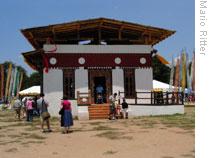 |
| A Bhutanese temple at the Folklife Festival |
As you walk through the area about Bhutan at the Smithsonian Folklife Festival, it is easy to forget you are in Washington. There are Bhutanese people walking around in traditional costumes and tall prayer flags waving in the wind. There is even a Bhutanese religious center where you can watch dances and performances. Some of the traditional dances date back to the sixteenth century. Bhutan's rich culture has been carefully protected because it is generally removed from outside influences.
There are many tented areas where you can learn more about this small Buddhist4 country in the Himalayan mountains. You might learn that Bhutan's national sport is archery. Or that the Bhutanese government has a policy of measuring the Gross Domestic Happiness in the country.
One area teaches visitors about Bhutan's postage stamps. Since the nineteen sixties, the country has developed unusual stamps including metal stamps and stamps that smell.
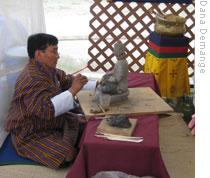 |
| A Bhutanese artisan |
Many booths teach visitors about Bhutanese artistic5 traditions like wood-carving, painting and cloth-making. At one booth, you can listen to a demonstration6 about the culture of drinking.
SPEAKER: The name for Bhutan in Bhutanese is druk…D-R-U-K. And Druk is a thunder dragon. This session is on how the dragon drinks. What do we drink? We drink alcohol. Then we drink tea!
The speaker gave a careful explanation of the respectful way to drink tea when you are invited to visit a Bhutanese home. If listening to this makes you thirsty, you can try Bhutanese drinks -- or food.
We tried the national dish of Bhutan, Ema Datsi. It is made from chilies7 and cheese and served with red rice. It was very spicy8 hot, but very delicious.
(MUSIC)
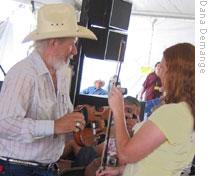 |
| Fiddlin' Frenchie Burke gets an audience member to help him play the fiddle9 |
A few steps away, festival visitors enter a whole other world, the culture of the southwestern American state of Texas. Known as the "Lone10 Star State," Texas has a rich culture and history. The festival has two performance stages for Texas music. You can hear the fast playing of Fiddlin' Frenchie Burke. He can play his fiddle backwards11, forwards and upside down.
Or you can hear cowboy songs performed by the Gillette Brothers from Crockett, Texas.
(MUSIC)
There are also bands playing Tejano, Creole, mariachi, and polka music.
The Texas area of the Folklife Festival also has a booth where you can learn about wine made in the state. And, there is a stage where experts talk about the state's many food traditions. For example, you can learn about the influences of cowboy, Mexican and Vietnamese cooking. Then you can taste examples at one of the festival's three Texas food sellers.
The festival's third subject is not one you might expect at a folklife event. Faith Lapidus tells us about it.
FAITH LAPIDUS:
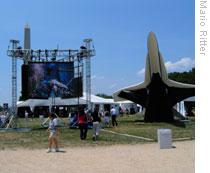 |
| Part of the NASA exhibit on the Mall |
The United States space agency is also represented at the Folklife Festival. NASA is celebrating its fiftieth anniversary this year. Space exploration may not seem to fit with the themes of folklife in Bhutan or Texas. NASA says the people who work at the agency usually discover new things rather than preserve old traditions. But the culture of engineers and scientists represents a community with special work skills that are an important part of American life.
About two hundred scientists, educators, engineers and astronauts are taking part in the NASA exhibit at the festival. They give talks, answer visitors' questions, demonstrate current space technology and suggest future developments.
In one discussion at the main tent called Exploration Stage, experts talk about the reasons we explore space. Steven Dick is chief historian for NASA. He was joined by chief NASA scientist, James Garvin, and curator of the National Air and Space Museum, Roger Launius. They discuss how space science has taught us about events in the distant past like the formation of the moon's surface. They offer reasons why it is important to return to the moon. And they make some predictions about the next fifty years.
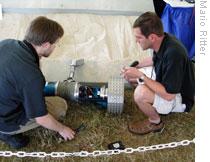 |
| Issa Nesnas, right, and Jeffrey Edlund of the Jet Propulsion Laboratory show visitors the inside of the exploration robot Axel |
One popular talk is about the space shuttle, the only reusable spaceship ever made. Former astronaut Carl Walz describes what it was like to experience a shuttle launch. He says nothing prepares first time astronauts for the sudden, shaking force of the powerful rocket engines.
There are also many demonstrations12 of space technology at the NASA exhibit -- from rocket engines to spacesuits. A team from the California Institute of Technology and NASA's Jet Propulsion Laboratory show a robot. It is designed to be lowered from a lander, like the Mars rover, into craters13 to gather soil and take pictures.
There is so much at the NASA exhibit that it is impossible to describe it all here. But the NASA employees who have come to the Folklife Festival are showing their special culture of discovery and adventure.
(MUSIC)
John Philip Sousa
HOST:
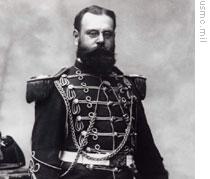 |
| John Philip Sousa |
Our listener question this week comes from Brazil. Tino Therezo likes the music of American composer John Philip Sousa and asks if he was of Portuguese14 ancestry15.
Indeed, he was. John Philip Sousa was born in Washington, D.C., in eighteen fifty-four. His father was born in Spain of Portuguese parents. His mother was Bavarian.
John was six when he began learning to play the violin and write music. His father was a musician in the United States Marine16 Band. John joined him in the Marine Corps17 as a special "apprentice18" or learning musician when he was just thirteen. He remained in the band until he was twenty.
In eighteen eighty, Sousa became leader of the Marine Band. He wrote this song, "Semper Fidelis," a few years later in honor of the officers and men of the Marine Corps. It is the official march of the Marine Corps.
(MUSIC)
In eighteen eighty-nine, the Washington Post newspaper asked Sousa to write a march for a contest the paper was having. "The Washington Post March" is still popular today. The song led to Sousa's nickname as the "March King." He wrote more than one hundred thirty marches in all.
(MUSIC)
Friday is a special day in the United States. On July fourth Americans celebrate Independence Day. People around the country celebrate the holiday with picnics, fireworks, parades and music. We leave you with "The Stars and Stripes Forever," the official march of the United States, written by John Philip Sousa.
(MUSIC)
HOST:
I'm Doug Johnson. I hope you enjoyed our program today.
It was written by Caty Weaver19, Mario Ritter and Dana Demange, who was also our producer. To read the text of this program and download audio, go to our Web site, voaspecialenglish.com.
Send your questions about American life to [email protected]. And please include your full name and where you are from. Or write to American Mosaic, VOA Special English, Washington, D.C., two-zero-two-three-seven, U.S.A.
Join us again next week for AMERICAN MOSAIC, VOA's radio magazine in Special English.
 收听单词发音
收听单词发音 




